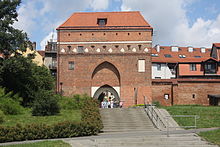Monastery Gate (Toruń)
The monastery gate in Toruń ( Brama Klasztorna in Polish ), also known as the Holy Spirit Gate , Nonnentor or Frauentor , is one of the three gates of the medieval Thorn that have survived to this day .
location
The gate is located in the southern part of the old town of Toruń , on Heiligengeist Street 2a ( ul. Św. Ducha ), east of the Leaning Tower.
history
The gate was built in the Flemish Gothic style, which is characterized by its solid construction. The monastery gate is reminiscent of the Paulinertor in the old town, which however no longer exists. The construction was completed in the first half of the 14th century. The development of war technology, especially the spread of firearms, made it necessary to add heights to the gate, which was carried out around 1420.
There was a portcullis in the ogival niche on the outer side of the gate. There was a hole in the ceiling of the doorway from which hot liquids or oil could be poured on the potential attacker. The next obstacle was the gate, which, if necessary, was reinforced from the city side by additional beams that were locked in special openings in the gate wall.
In the 19th century, the gate lost its defensive function and was redesigned so that its rooms could be inhabited.
The name of the gate refers to the Benedictine monastery just outside the walls, where there was a hospital and the Church of the Holy Spirit. The church existed until the 17th century. This is where the name of both the gate and the Heiligengeiststraße comes from.
Since October 1943 there has been an air raid shelter for 100 people (probably built for port workers or guest workers) under the gate, which is now open to visitors.
gallery
Individual evidence
- ↑ Małgorzata Oberlan: Perełki for bocznych szlaków. Nowości, Magazyn 7 dni, 2015-05-22. Retrieved July 1, 2020 (Polish).
Web links
- Baszty i bramy. Brama Klasztorna (Polish)
- Bramy. Brama Klasztorna (Polish)
Coordinates: 53 ° 0 ′ 29.7 ″ N , 18 ° 36 ′ 13 ″ E





